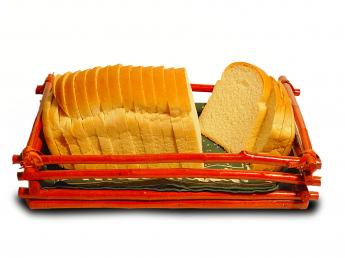The Greatest Thing Since 1928

Turns out, it is. But in order for us to collectively learn that lesson, American government had to ban it.
Sliced bread — machine-sliced, that is — was almost invented in 1912, when a man named Otto Fredrick Rohwedder came up with a prototype and blueprints for an automated bread slicing machine, but lost his work to a fire. Undeterred, Rohwedder rebuilt the machine held in his mind’s eye. In 1928, he had a machine up and running, and by July of that year, sliced bread was being machine-produced for the masses. The marketing behind the product set the stage for the neologism used today, as Rohwedder’s bread was advertised as “the greatest forward step in the baking industry since bread was wrapped.” By 1930, Wonder Bread switched to a sliced bread product, selling machine-sliced bread nationwide for the first time.
Sliced bread made bread consumption increase, as expected. But when World War II rationing came to the forefront of the American economic war effort, Food Administrator Claude Wickard targeted the greatest invention of the century (so to speak). Hoping to reduce the amount of wax paper used in general — because, Wickard presumed, sliced bread required more wax paper than its unsliced counterpart — and also hoping to reduce bread prices, Wickard banned the sale of sliced bread domestically, effective January 18, 1943. This was immediately met with protestations from housewives arguing that their household efficiencies were crippled by a short-sighted ban. Because, after all, sliced bread is the greatest thing in recent memory.
Local politicians took the matter into their own hands, with New York City major Fiorello LaGuardia noting that bakeries could use their own bread-slicing machines, selling the freshly-baked (and sliced) product direct to their customers. But that received the kibosh days later, with the Food Distribution Association requiring the cessation of any commercial bread slicing, in order to protect those bakeries which either did not have bread slicing machinery or who wished to do their all for the country’s war efforts.
In any event, the ban was short lived. On March 8, sliced bread was once again allowed in the United States, its greatness preserved for generations present and future.
Bonus fact: Toilet paper is not the greatest thing since sliced bread — it can’t be, because toilet paper predates it by over fifty years. Commercial toilet paper was invented in 1857 by a New Yorker named Joseph Gayetty, who sold packs of 500 sheets (each containing a watermark with his name) for fifty cents. The product was called “the greatest necessity of the age” per its marketing language, so perhaps, sliced bread is the greatest thing since toilet paper.
From the Archives: Reading Them The Riot Act: The etymology of another common phrase.
Related: In modern times, bread slicers are available for purchase by consumers who wish to have an industrial flair added to their kitchen. The slicing machines cost about $800.

Leave a comment